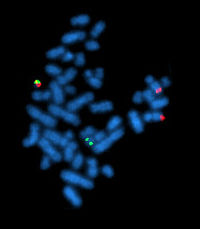
Photo from wikipedia
Simple Summary Acute myeloid leukemia is an aggressive cancer in children and novel therapeutic tools are warranted to improve outcomes and reduce late effects in these patients. In this study,… Click to show full abstract
Simple Summary Acute myeloid leukemia is an aggressive cancer in children and novel therapeutic tools are warranted to improve outcomes and reduce late effects in these patients. In this study, we isolate and explore the protein profiles of leukemic stem cells and normal hematopoietic stem cells from hematologically healthy children. Differences in protein profiles between leukemic and normal hematopoietic stem cells were identified. These results provide an insight into the disrupted biological pathways in childhood acute myeloid leukemia. Moreover, differences in protein profiles may serve as potential targets for future therapies specifically aiming at the disease-propagating leukemic stem cells while omitting the normal hematopoietic stem cells. Abstract Novel therapeutic tools are warranted to improve outcomes for children with acute myeloid leukemia (AML). Differences in the proteome of leukemic blasts and stem cells (AML-SCs) in AML compared with normal hematopoietic stem cells (HSCs) may facilitate the identification of potential targets for future treatment strategies. In this explorative study, we used mass spectrometry to compare the proteome of AML-SCs and CLEC12A+ blasts from five pediatric AML patients with HSCs and hematopoietic progenitor cells from hematologically healthy, age-matched controls. A total of 456 shared proteins were identified in both leukemic and control samples. Varying protein expression profiles were observed in AML-SCs and leukemic blasts, none having any overall resemblance to healthy counterpart cell populations. Thirty-four proteins were differentially expressed between AML-SCs and HSCs, including the upregulation of HSPE1, SRSF1, and NUP210, and the enrichment of proteins suggestive of protein synthesis perturbations through the downregulation of EIF2 signaling was found. Among others, NUP210 and calreticulin were upregulated in CLEC12A+ blasts compared with HSCs. In conclusion, the observed differences in protein expression between pediatric patients with AML and pediatric controls, in particular when comparing stem cell subsets, encourages the extended exploration of leukemia and AML-SC-specific biomarkers of potential relevance in the development of future therapeutic options in pediatric AML.
Journal Title: Cancers
Year Published: 2022
Link to full text (if available)
Share on Social Media: Sign Up to like & get
recommendations!